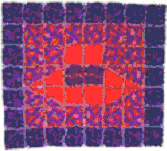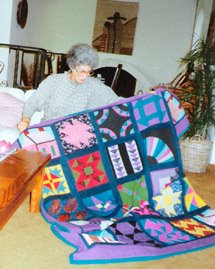Signing and Dating Quilts
How often have you admired a quilt and wondered who made it and when it was made? If you’re anything like me, frequently once I sew the last stitch of binding on the quilt, I declare it complete – without a name label.
Now that I have a collection of many quilts, when I made them has become a blur that I wish were different. And I remember all of the quilts I have given away with no identifying mark.
You can prevent that by signing and dating your quilt. Fabric markers make it a simple and quick. Or you can create a label and stitch it onto your quilt. Get creative with your quilt label – you’ve spent hours creating your heirloom, allow future generations to appreciate your work by name.
Here are some tips for marking your quilts:
a) Include your complete name – first, last and maiden name. Tracing quilts through families becomes easier if all names are included.
b) If your quilt was a community project, include the names of everyone who participated.
c) Record the entire date when the quilt was completed – month, day and year.
d) Add information about events surrounding the quilt will give the quilt a sustaining history – the birth of a baby (specifically named in the label), marriage of a couple (named in the label), a son or daughter going off to school…..you get the idea.
e) Specify where the quilt was made – city and country.
Happy Quilting!
Penny Halgren
www.how-to-quilt.com
Penny is a quilter of more than 24 years who seeks to interest new quilters and provide them with the resources necessary to create beautiful quilts.
This article courtesy of http://www.How-To-Quilt.com. You may freely reprint this article on your website or in your newsletter provided this courtesy notice and the author name and URL remain intact.
How often have you admired a quilt and wondered who made it and when it was made? If you’re anything like me, frequently once I sew the last stitch of binding on the quilt, I declare it complete – without a name label.
Now that I have a collection of many quilts, when I made them has become a blur that I wish were different. And I remember all of the quilts I have given away with no identifying mark.
You can prevent that by signing and dating your quilt. Fabric markers make it a simple and quick. Or you can create a label and stitch it onto your quilt. Get creative with your quilt label – you’ve spent hours creating your heirloom, allow future generations to appreciate your work by name.
Here are some tips for marking your quilts:
a) Include your complete name – first, last and maiden name. Tracing quilts through families becomes easier if all names are included.
b) If your quilt was a community project, include the names of everyone who participated.
c) Record the entire date when the quilt was completed – month, day and year.
d) Add information about events surrounding the quilt will give the quilt a sustaining history – the birth of a baby (specifically named in the label), marriage of a couple (named in the label), a son or daughter going off to school…..you get the idea.
e) Specify where the quilt was made – city and country.
Happy Quilting!
Penny Halgren
www.how-to-quilt.com
Penny is a quilter of more than 24 years who seeks to interest new quilters and provide them with the resources necessary to create beautiful quilts.
This article courtesy of http://www.How-To-Quilt.com. You may freely reprint this article on your website or in your newsletter provided this courtesy notice and the author name and URL remain intact.




